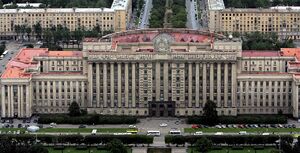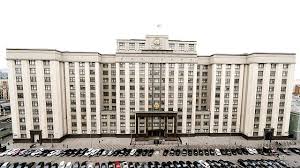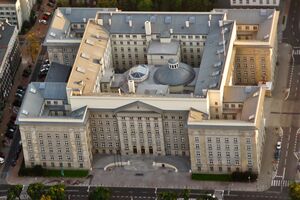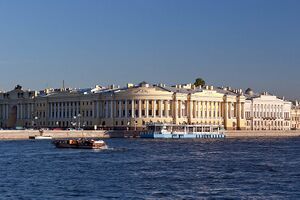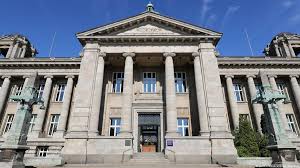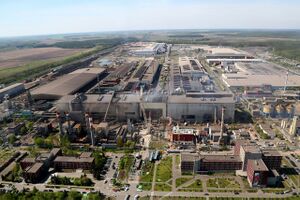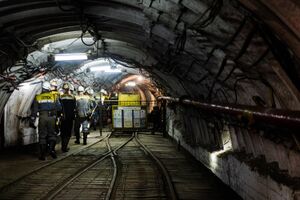Garindina: Difference between revisions
(→Mining) |
No edit summary |
||
| (36 intermediate revisions by 2 users not shown) | |||
| Line 1: | Line 1: | ||
{{Infobox country | {{Infobox country | ||
|conventional_long_name = Garindinan United Federation | |conventional_long_name = Garindinan United Federation | ||
|native_name = Гариндинан Объединенная Федерация<br> Об'єднана федерація Гаріндіна | |native_name = (Garindinan) Гариндинан Объединенная Федерация<br> (Yuzhstovan) Об'єднана федерація Гаріндіна | ||
|common_name = Garindina | |common_name = Garindina | ||
|image_flag = flagof Garindina.png | |image_flag = flagof Garindina.png | ||
| Line 13: | Line 13: | ||
|largest_city = [[Jasanasburg]] | |largest_city = [[Jasanasburg]] | ||
|image_map = Map of Garindina.png | |image_map = Map of Garindina.png | ||
|map_caption = {{PAGENAME}} in Argis | |map_caption = {{PAGENAME}} in Argis | ||
|official_languages = Garindinan, Yuzhstovan | |official_languages = Garindinan, Yuzhstovan | ||
|national_languages = | |national_languages = | ||
| Line 23: | Line 23: | ||
|languages2 = | |languages2 = | ||
|languages2_sub = | |languages2_sub = | ||
|ethnic_groups = | |ethnic_groups =49% Garindinan<br/>32% Yuzhstovan<br>10% Korelian<br>3% Other<br>2% Doro<br>2% Rusic<br>2% Lakoudiskfolkæ | ||
|ethnic_groups_year = | |ethnic_groups_year = | ||
|ethnic_groups_ref = | |ethnic_groups_ref = | ||
| Line 37: | Line 37: | ||
|leader_title3 = Head Councilwoman | |leader_title3 = Head Councilwoman | ||
|leader_name3 = Natasha Ivanova | |leader_name3 = Natasha Ivanova | ||
|leader_title4 = Prime Minister | |leader_title4= Chairman of the State Duma | ||
| | |leader_name4= Ivan Kovalenko | ||
|leader_title5 = Prime Minister | |||
|leader_name5 = Gregory Brezhnev | |||
<!--......--> | <!--......--> | ||
|leader_title14 = <!--(up to 14 distinct leaders may be included)--> | |leader_title14 = <!--(up to 14 distinct leaders may be included)--> | ||
| Line 66: | Line 68: | ||
|population_estimate_rank = | |population_estimate_rank = | ||
|population_estimate_year = | |population_estimate_year = | ||
|population_census = | |population_census =2020 | ||
|population_census_year = | |population_census_year = | ||
|population_density_km2 = 27.77 | |population_density_km2 = 27.77 | ||
| Line 82: | Line 84: | ||
|GDP_nominal_per_capita = 18,700 | |GDP_nominal_per_capita = 18,700 | ||
|GDP_nominal_per_capita_rank = | |GDP_nominal_per_capita_rank = | ||
|Gini = | |Gini = 30.2 | ||
|Gini_ref = | |Gini_ref = | ||
|Gini_rank = | |Gini_rank = | ||
| Line 103: | Line 105: | ||
|iso3166code = | |iso3166code = | ||
|calling_code = +55 | |calling_code = +55 | ||
|patron_saint = Saint | |patron_saint = Saint Pavel | ||
|p1 = | |p1 = | ||
|flag_p1 = | |flag_p1 = | ||
| Line 129: | Line 131: | ||
== Etymology == | == Etymology == | ||
The name "Garindina" derives from ancient Yasic roots, reflecting the old pagan spiritual beliefs of the region. In the ancient pagan beliefs of Garindina, Garin is the chief god of the Kraynaduk Faith (Yasic Paganism). Garin in both the old and new beliefs, is the god of the sky, lightning, thunder, and physical realm. The land itself was seen as a manifestation of this divine power, often referred to as the "Land of Garin" in reverence to the deity's influence over the region's natural elements and the people's daily lives. | The name "Garindina" derives from ancient Yasic roots, reflecting the old pagan spiritual beliefs of the region. In the ancient pagan beliefs of Garindina, Garin is the chief god of the [[Kraynaduk Faith]] (Yasic Paganism). Garin in both the old and new beliefs, is the god of the sky, lightning, thunder, and physical realm. The land itself was seen as a manifestation of this divine power, often referred to as the "Land of Garin" in reverence to the deity's influence over the region's natural elements and the people's daily lives. | ||
== Geography == | == Geography == | ||
| Line 162: | Line 164: | ||
| [[File:Borovskaya Oblast.jpeg|28px|border]] Borovskaya || Shishkovgrad || Yaroslav Kozlov | | [[File:Borovskaya Oblast.jpeg|28px|border]] Borovskaya || Shishkovgrad || Yaroslav Kozlov | ||
|- | |- | ||
| [[File: | | [[File:Korelisk Oblast.jpeg|28px|border]] Korelisk || Dovgazalsk || Koldan Kulikov | ||
|- | |- | ||
| [[File:Ravno Oblast.png|28px|border]] Ravno || Koganelsk || Yelysaveta Dmytruk | | [[File:Ravno Oblast.png|28px|border]] Ravno || Koganelsk || Yelysaveta Dmytruk | ||
| Line 186: | Line 188: | ||
! colspan='3' | Territory | ! colspan='3' | Territory | ||
|- | |- | ||
| [[File:Flag of Yedo.png|28px|border]] Overseas Territory of Yedo || [[Yedo]] || Prime Minister Henzo Vukunaga | | [[File:Flag of Yedo.png|28px|border]] Overseas Territory of Yedo || [[Yedo]] || Prime Minister Henzo Vukunaga | ||
|- | |- | ||
! colspan='3' | Republics | ! colspan='3' | Republics | ||
|- | |- | ||
| [[File:Republic Doria.jpeg|28px|border]] Doria || Byalŭk || Nikolai Georgiev | | [[File:Republic Doria.jpeg|28px|border]] Doria || Byalŭk || Nikolai Georgiev | ||
|- | |- | ||
| [[File:Republic Yuzhstova.png|28px|border]] Yuzhstova || Fermivka || Leader* | | [[File:Republic Yuzhstova.png|28px|border]] Yuzhstova || Fermivka || Leader* | ||
| Line 263: | Line 265: | ||
=== Government === | === Government === | ||
The governance structure in Garindina is intricate and, at times, | The governance structure in Garindina is intricate and, at times, confusing. Classified as an {{wp|Anocracy|Anocratic State}}, Garindina's government restricts national-level elections, permitting only local-level electoral processes. Operating as a Semi-Constitutional Federal Monarchy and a {{wp|one-party state}} led by the National Royalist Party (NRP). The NRP serves as the sole political party within the nation. The power in the country is centralized within three levels of government: the '''monarchy''', the '''central government''' (consisting of the '''Federal Council''', the '''State Duma''', and the '''Council of Ministers'''), and the '''Supreme Court'''. | ||
At the top, the monarchy holds ultimate authority, with decisions made by the Crown enacted by the Council of Ministers to bring about changes. The central government, which includes the Federal Council, governs the '''Oblasts''' and '''Administrative Districts (ADs)''' of Garindina. However, all discussions and decisions within the central government require approval from the Crown. | At the top, the monarchy holds ultimate authority, with decisions made by the Crown enacted by the Council of Ministers to bring about changes. The central government, which includes the Federal Council, governs the '''Oblasts''' and '''Administrative Districts (ADs)''' of Garindina. However, all discussions and decisions within the central government require approval from the Crown. | ||
| Line 275: | Line 277: | ||
{{main|Garindinan Monarchy}} | {{main|Garindinan Monarchy}} | ||
[[File:Royal Palace of Garindina.jpeg|thumb|left|The Royal Palace of Garindina]] | [[File:Royal Palace of Garindina.jpeg|thumb|left|The Royal Palace of Garindina.]] | ||
The Monarchy of Garindina dates back to the first civilizations of the Gari people. Garindina is run by a {{wp|hereditary monarchy}} and its current monarch is Czarina Nadia V. The monarchy can be split into two sections, the '''Old Monarchy''' and the '''New Monarchy'''. This split is defined by the abolishment of the monarchy after the October Coup, currently Garindina is ruled by the new monarchy. The New Monarchy has ruled Garindina since 1998, after the end of the Garindinan Civil War. The first “New Monarch” was Czar Aleksandr Yakolev, and he reigned until his death on July | [[File:Kachanivka panorama.jpg|thumb|right|The Summer Palace, 58 km from Fermivka.]] | ||
The Monarchy of Garindina dates back to the first civilizations of the [[Gari people]]. Garindina is run by a {{wp|hereditary monarchy}} and its current monarch is Czarina Nadia V. The monarchy can be split into two sections, the '''Old Monarchy''' and the '''New Monarchy'''. This split is defined by the abolishment of the monarchy after the October Coup, currently Garindina is ruled by the new monarchy. The New Monarchy has ruled Garindina since 1998, after the end of the Garindinan Civil War. The first “New Monarch” was Czar Aleksandr Yakolev, and he reigned until his death on {{date|17 July 2015}}. | |||
The Monarchs are Commander-in-Chief of the Garindinan Armed Forces and hold the authority to declare war and make alliances. Meaning that the entirety of the Garindinan Armed Forces and the Royal Guard are under the command of the Monarch. The Monarchy determines foreign policy and must sign all Acts, Bills and Laws for them to be enacted upon. Monarchs have the power to appoint Oblast and AD governors and the members of the Council of Ministers. The Monarch can also appoint the members of the Supreme Court, giving the Monarch absolute power over the Garindinan legal system. Not only that, but the Monarch also has direct control over the territories of Garindina. | The Monarchs are Commander-in-Chief of the Garindinan Armed Forces and hold the authority to declare war and make alliances. Meaning that the entirety of the Garindinan Armed Forces and the Royal Guard are under the command of the Monarch. The Monarchy determines foreign policy and must sign all Acts, Bills and Laws for them to be enacted upon. Monarchs have the power to appoint Oblast and AD governors and the members of the Council of Ministers. The Monarch can also appoint the members of the Supreme Court, giving the Monarch absolute power over the Garindinan legal system. Not only that, but the Monarch also has direct control over the territories of Garindina. | ||
| Line 285: | Line 289: | ||
[[File:Federal Assembly Building.jpeg|thumb|right|The Federal Assembly]] | [[File:Federal Assembly Building.jpeg|thumb|right|The Federal Assembly]] | ||
The Central Government of Garindina comprises two departments, the '''Federal Council''' and the '''State Duma'''. These two departments make up the central body of the Garindinan government. These two counsels meet | The Central Government of Garindina comprises two departments, the '''Federal Council''' and the '''State Duma'''. These two departments make up the central body of the Garindinan government. These two counsels meet six times a year at the [[Federal Assembly (Garindina)|Federal Assembly]] and discuss goals for the year. wip | ||
===== Federal Council ===== | ===== Federal Council ===== | ||
| Line 301: | Line 305: | ||
[[File:Garindinan State Duma.jpeg|thumb|right|The State Duma Building]] | [[File:Garindinan State Duma.jpeg|thumb|right|The State Duma Building]] | ||
Unlike other elements of government, the State Duma has the unique power to counter the monarchy. The State Duma is composed of a ninety-person council and is headed by Chairman Ivan Kovalenko. WIP | |||
===== Council of Ministers ===== | ===== Council of Ministers ===== | ||
| Line 307: | Line 311: | ||
[[File:Council of Ministers Building.jpeg|thumb|left|The Council of Ministers Building]] | [[File:Council of Ministers Building.jpeg|thumb|left|The Council of Ministers Building]] | ||
The '''Council of Ministers''' comprises eight different ministries. With each minister being hand-picked by the monarch as well as the | The '''Council of Ministers''' comprises the eight different ministries and is headed by Prime Minister Gregory Brezhnev. With each minister being hand-picked by the monarch as well as the prime minister, who is in control of the council. Each minister controls their own sector of administration and all decisions made by the Federal Council and the monarchy are put into effect by their respective ministry. Ministers have the power to create their own policies, but these policies must be approved by the monarch to be put into effect. But in the occasion of a policies being denied, they can edit it and send it through the federal assembly and have it approved. Despite this, the monarch can still veto the policy if seen necessary. | ||
The Prime Minister is the head of the Council of Ministers and also represents the Council in the Federal Assembly. wip | |||
===== Ministries ===== | ====== Ministries ====== | ||
{|class='wikitable' | {|class='wikitable' | ||
| Line 384: | Line 390: | ||
==== Federal Police ==== | ==== Federal Police ==== | ||
The Federal Police of Garindina are the main law enforcement body in Garindina. Each region has their own police offices headed by their own regional director. The Federal Police Services are responsible for the safety of all citizens, as well as all Government Issued Identification to all citizens. | The Federal Police of Garindina are the main law enforcement body in Garindina. Each region has their own police offices headed by their own regional director. The Federal Police Services are responsible for the safety of all citizens, as well as all Government Issued Identification to all citizens. | ||
==== Corruption ==== | ==== Corruption ==== | ||
The Anti-Corruption Police (AKSP) is the newest police force in Garindina tasked with countering corruption in Garindina. The AKSP is a semi-independent police force that operates under the Monarchy. The AKSP, was established on {{date|14 May 2023}}, as part of the Garindinan Reformation. A series of reforms in Garindina repairing systems that were inefficient and only worsened the corruption within Garindina. | The Anti-Corruption Police (AKSP) is the newest police force in Garindina tasked with countering corruption in Garindina. The AKSP is a semi-independent police force that operates under the Monarchy. The AKSP, was established on {{date|14 May 2023}}, as part of the Garindinan Reformation. A series of reforms in Garindina repairing systems that were inefficient and only worsened the corruption within Garindina. WIP (how do they operate?) | ||
== Economy == | == Economy == | ||
The Garindinan economy is a mixed economy, with government-controlled companies being common. The top three industries in Garindina are petroleum refinement, environmental tourism, and manufacturing. The Grivna is the national currency of Garindina and is also slightly inflated, making 1 Г̷̶̷ being equal to A$ | The Garindinan economy is a mixed economy, with government-controlled companies being common. The top three industries in Garindina are petroleum refinement, environmental tourism, and manufacturing. The Grivna is the national currency of Garindina and is also slightly inflated, making 1 Г̷̶̷ being equal to A$2.8. The minimum wage of Garindina is only 20 Г̷̶̷/hour, with a national tax rate of 35%. | ||
=== Agriculture & Fishery=== | === Agriculture & Fishery=== | ||
[[File:Yuzhstovan Wheat Feild .jpeg|thumb|left|A wheat feild in Yuzhstova]] | |||
Garindina's Agriculture Sector is predominately based in Yuzhstova, where the fertile land and favorable climate contribute to its crop yields. Staple crops such as wheat, potatoes, and cabbage flourish alongside a variety of melons and apples. The cultivation extends to the production of sunflower and vegetable oils, highlighting the diversity and productivity of the region’s agricultural sector. Garindina's agricultural production is limited more over to its northern latitude, leading to the use of greenhouses for some crops in the Korelisk Oblast. With the Korelisk Oblast focusing more on root vegetables like Beets, potatoes and radishes. | |||
In addition to its crop production, Garindina boasts a substantial dairy industry, with a particular focus on the northern regions. The nation’s dairy sector is marked by large-scale farms that contribute significantly to the production of milk and dairy products. The dairy sector is also characterized by a blend of both goat and cow milk production, with a sizeable about going towards cheese production. | |||
[[File:Mediargic King Crab.jpeg|thumb|right|A Garindinan crabber with a Canamo King Crab]] | |||
wip | |||
=== Energy === | === Energy === | ||
| Line 402: | Line 413: | ||
[[File:Krylov Damn.jpeg|thumb|left|The Krylov Damn near the [[Canamo Canal]].]] | [[File:Krylov Damn.jpeg|thumb|left|The Krylov Damn near the [[Canamo Canal]].]] | ||
Garindina has historically been an energy efficient country. Until around the 1960s, Garindina was run in coal plants. But after the passing of the 1964 {{wp|Clean Air Act}} Garindina started to move away from coal plants. During the Garindinan Civil War, many coal plants were destroyed, but the many Hydropower plants were left alone. As Garindina was still rebuilding, in 2005 | Garindina has historically been an energy efficient country. Until around the 1960s, Garindina was run in coal plants. But after the passing of the 1964 {{wp|Clean Air Act}} Garindina started to move away from coal plants. During the Garindinan Civil War, many coal plants were destroyed, but the many Hydropower plants were left alone. As Garindina was still rebuilding, in 2005 Czar Aleksandr began to build wind and solar farms across Garindina, kickstarting the clean energy program. Slowly, Garindina began to move away from Coal and Oil. Today, 67% of all energy production in Garindina is produced by renewable resources. | ||
{{Pie chart | {{Pie chart | ||
| Line 464: | Line 475: | ||
| other = | | other = | ||
| label1 = Garindinian | | label1 = Garindinian | ||
| value1 = | | value1 = 49 | ||
| color1 = crimson | | color1 = crimson | ||
| label2 = Yuzhstovan | | label2 = Yuzhstovan | ||
| value2 = | | value2 = 32 | ||
| color2 = blue | | color2 = blue | ||
| label3 = Korelian | | label3 = Korelian | ||
| color3 = orange | | color3 = orange | ||
| value3 = | | value3 = 10 | ||
| label4 = | | label4 = Other | ||
| value4 = 3 | | value4 = 3 | ||
| color4 = | | color4 = grey | ||
| label5 = | | label5 = Doro | ||
| value5 = | | value5 = 2 | ||
| color5 = | | color5 = green | ||
| label6 = Rusic | | label6 = Rusic | ||
| value6 = 2 | | value6 = 2 | ||
| Line 486: | Line 497: | ||
}} | }} | ||
Garindina is | Garindina is a very ethnically diverse nation. Most of the population are considered ethnic Garindinans and Yuzhstovans with large Korelian and Doro communities. With smaller communities of Rusics and Lakkiudiskfolkæ and other smaller ethnic communities. Ethnic tensions are low and very little ethnic violance happens within the country, aside from the occasional descrimination between Garindinans and Korelians. | ||
=== Religion === | === Religion === | ||
| Line 498: | Line 509: | ||
| color1 = blue | | color1 = blue | ||
| label2 = Non Affiliated | | label2 = Non Affiliated | ||
| value2 = | | value2 = 18 | ||
| color2 = grey | | color2 = grey | ||
| label3 = Kraynaduk Faith | | label3 = Kraynaduk Faith | ||
| value3 = | | value3 = 8 | ||
| color3 = silver | | color3 = silver | ||
}} | }} | ||
The freedom of religion is a guaranteed right in Garindina. Despite this, the national religion being Garindinan Orthodox. Garindinan Orthodox is the most prominent religion practiced in Garindina, with | The freedom of religion is a guaranteed right in Garindina. Despite this, the national religion being Garindinan Orthodox. Garindinan Orthodox is the most prominent religion practiced in Garindina, with 7.3 million followers within Garindina. In recent years, a growing number of people identify as irreligious, with 1.7 million people identifying as irreligious. | ||
===Health=== | ===Health=== | ||
| Line 513: | Line 524: | ||
== Culture == | == Culture == | ||
Garindina, having many ethnic groups is very culturally diverse. With each ethnic group having their own unique characteristics and traditions. This differentiation of cultures comes from the geography and history of Garindina. Garindinan traditions take roots from the Early Gari People that who migrated to the Paras River Valley during the Late Gari Migration. As a result of the migration, some of these cultures mixed and are similar but still distinct from each other. | |||
===Art=== | ===Art=== | ||
| Line 551: | Line 562: | ||
* New year celebrations: Dec 31-Jan 1 | * New year celebrations: Dec 31-Jan 1 | ||
* The Czarina's birthday: March 22 | * The Czarina's birthday: March 22 | ||
* Saint Pavel’s Day: Last Sunday of May | |||
* {{wp|Midsummer}}: June 23-25 | * {{wp|Midsummer}}: June 23-25 | ||
* Remembrance Day: July 17 | * Remembrance Day: July 17 | ||
| Line 557: | Line 569: | ||
'''Notable Regional Holidays:''' | '''Notable Regional Holidays:''' | ||
* Day of the First Prince: April 17, celebrates the crowning of the First Yuzhstovan Knyaz. | * Day of the First Prince: April 17, celebrates the crowning of the First Yuzhstovan Knyaz. | ||
* Day of Korelian Speech: July 24, celebrates Korelian Language. | |||
* Day of | * Day of our Gods: July 4, celebrates the Dorian resistance from Christiansation | ||
* | * Saint Gleb’s Feast: June 1, Celebrates Saint Gleb for his Virtues of humility and compassion. (Garindinan) | ||
* | |||
'''Notable Festivals''' | '''Notable Festivals''' | ||
* | * Spring Festivals: April 20-30, Location: Yuzhstova & Doria | ||
* WIP | |||
=== Sports === | === Sports === | ||
| Line 572: | Line 584: | ||
WIP | WIP | ||
[[Category:Monarchies]] | |||
[[Category:Semi-Constitutional Monarchies]] | |||
[[Category:Garindina]] | [[Category:Garindina]] | ||
[[Category:Eurth]] | |||
{{Eurth}} | {{Eurth}} | ||
Revision as of 05:15, 15 May 2024
Garindinan United Federation (Garindinan) Гариндинан Объединенная Федерация (Yuzhstovan) Об'єднана федерація Гаріндіна | |
|---|---|
| Motto: Монархия, Федерация, Прогресс Монархія, Федерація, Прогрес (Monarchy, Federation, Progress) | |
| Anthem: National Anthem of Garindina | |
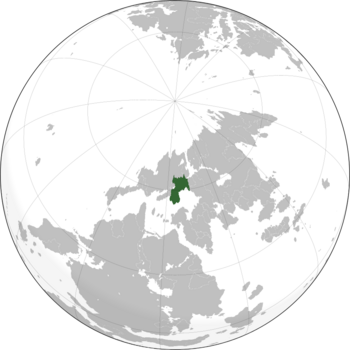 Garindina in Argis | |
| Capital | Parsa |
| Largest city | Jasanasburg |
| Official languages | Garindinan, Yuzhstovan |
| Recognised regional languages | Doro, Rusic, Korelian |
| Ethnic groups | 49% Garindinan 32% Yuzhstovan 10% Korelian 3% Other 2% Doro 2% Rusic 2% Lakoudiskfolkæ |
| Religion | Garindinan Orthodox |
| Demonym(s) | Garindinan |
| Government | Semi-Constitutional Federal Monarchy under One-Party rule |
• Czarina | Nadia V |
• Speaker of the Assembly | Anatolii Zaytsev |
• Head Councilwoman | Natasha Ivanova |
• Chairman of the State Duma | Ivan Kovalenko |
• Prime Minister | Gregory Brezhnev |
| Legislature | Federal Assembly |
| State Duma | |
| Federal Council | |
| Independent State | |
• The Garindinan Empire | December 20, 1350 - July 17, 1871 |
• The Constitution War | March 23, 1869 - July 17, 1871 |
• The October Coup | October 17, 1933 |
• The Garindinan Civil War | March 31, 1983 - September 2, 1996 |
| Area | |
• | 366,296 km2 (141,428 sq mi) |
| Population | |
• Estimate | 9,958,401 |
• Census | 2020 |
• Density | 27.77/km2 (71.9/sq mi) |
| GDP (nominal) | estimate |
• Total | 181.39 billion |
• Per capita | 18,700 |
| Gini | 30.2 medium |
| Currency | Grivna (Г̷̶̷ ) (GRV) |
| Time zone | UTC-4, UTC-3 |
| Date format | dd-mm-yyyy (AD) |
| Driving side | right |
| Calling code | +55 |
| Internet TLD | .gr |
This article or section is in the process of an expansion or major restructuring. You are welcome to assist in its construction by editing it as well. If this article or section has not been edited in several days, please remove this template. If you are the editor who added this template and you are actively editing, please be sure to replace this template with {{in use}} during the active editing session. Click on the link for template parameters to use.
This article was last edited by Definitely not a tree (talk | contribs) 5 months ago. (Update timer) |
Garindina, formally The Garindinan United Fedoration (Garindinan: Гариндинан Объединенная Федерация, Garindinan Ob"yedinennaya Federatsiya, Yuzhstovan: Об'єднана Федерація Гаріндінан, Ob'yednana federatsiya Harindina), is a sovereign nation in western Argis on Eurth. The country borders the Prymontian Rus to the North-East, North Dniester and Ahrana to the east, and Doria to the west. Garindina also has a boarder with Esonice via the treaty port of Yedo. Garindina has a coast with three bodies of water, these being the Canamo Sea, the Mediargic Sea, and the Sakspati Sea.
Garindina is classified as a Semi-Constitutional Federal Monarchy under One-Party rule. The political capital is Parsa and its largest city is Jasanasburg. The first civilization can be traced back to the Paras Gari in the 1st century BC. The head of state is Nadia V from the House of Yakolev-Vinogradov. The Garindinan Civil War (1983-1997) has left clear scars on the people of Garindina and the nation, with a change of government and the return of the Garindinan Monarchy.
Today, Garindina has a mixed economy with relativly low poverty rates due to the effects of the 1948 Right to Live Act. Garindina is a popular tourist destination with its many National parks and cultural activities. The nation has more than 9.95 million people who call Garindina home.
Garindina is mostly a neutral nation. Despite this, Ómaksa Accords is a mutual defense pact in away as to protect Ómaksa from outside forces. Garindina is also a part of the AN, ATARA, and BFG.
Etymology
The name "Garindina" derives from ancient Yasic roots, reflecting the old pagan spiritual beliefs of the region. In the ancient pagan beliefs of Garindina, Garin is the chief god of the Kraynaduk Faith (Yasic Paganism). Garin in both the old and new beliefs, is the god of the sky, lightning, thunder, and physical realm. The land itself was seen as a manifestation of this divine power, often referred to as the "Land of Garin" in reverence to the deity's influence over the region's natural elements and the people's daily lives.
Geography
(Picture Gallery)
The geography of Garindina is quite diverse. With flat lowlands and vast grasslands in the south and rocky hills, mountains and vast forest in the north.
Climate
WIP
- Climate Map
Flora and Fauna
WIP
- picture gallery
Subdivisions
| Map | Name | Capital | Governor, or *Head of State |
|---|---|---|---|
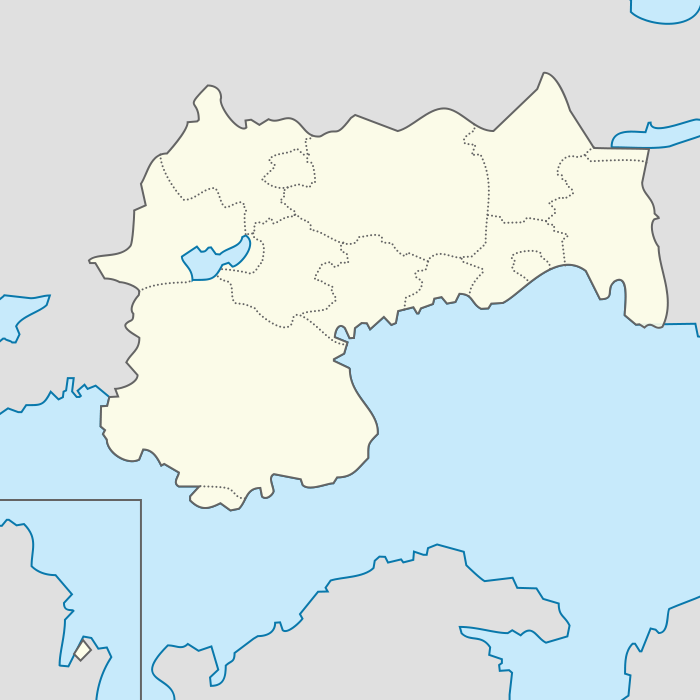
B.
J.
N.
|
Oblasts | ||
| Akmlinsk | Alma Soloveva | ||
| Visokogoriyegrad | Toma Novikov | ||
| Shishkovgrad | Yaroslav Kozlov | ||
| Dovgazalsk | Koldan Kulikov | ||
| Koganelsk | Yelysaveta Dmytruk | ||
| Rechnograd | Arina Koroleva | ||
| Vladigrad | Yustina Sokoloa | ||
| Zvyozdny | Timur Kozlov | ||
| Administrative districts | |||
| Borisobay | Nataliya Guseva | ||
| Jasanasburg | Yaromir Antonov | ||
| Novokamensk | Tatyana Belova | ||
| Parsa | Kazimir Vlasov | ||
| Yuzhemore | Nazar Onyshchuk | ||
| Territory | |||
| Yedo | Prime Minister Henzo Vukunaga | ||
| Republics | |||
| Byalŭk | Nikolai Georgiev | ||
| Fermivka | Leader* | ||
History
WIP
- The Garindinan Civil War (1983-1998) left clear scars on the people of Garindina and the nation. Its outcome was a change of government and the return of the Garindinan Monarchy.
- Today, Garindina has a mixed economy, with low poverty rates, thanks to the protections enacted by the 1948 Right to Live Act.
- Ómaksa Accords (year?) is a mutual defense pact in away as to protect Ómaksa from outside forces. Garindina is also a part of the BFG and…
Early History (500 BCE-100 CE)
First Princedoms (500 BCE-148 BCE)
wip
Unification of the Princedoms (148 BCE-115 BCE)
wip
Pre-Zmeyvar Period (115 BCE-100 CE)
wip
Zmeyvar Era (100CE-1137CE)
wip
Time of Troubles (1138-1279)
WIP
Age of Expansion (1280-1426)
Wip
Early Empire (1427-1614)
wip
Colonisation (1615-1859)
WIP
Modern Era (1860-1937)
wip
Bachvarov Era (1938-1964)
wip
Pre-Civil War (1965-1982)
wip
Civil War (1983-1997)
wip
Transitional Period (1998-2005)
wip
Politics
Government
The governance structure in Garindina is intricate and, at times, confusing. Classified as an Anocratic State, Garindina's government restricts national-level elections, permitting only local-level electoral processes. Operating as a Semi-Constitutional Federal Monarchy and a one-party state led by the National Royalist Party (NRP). The NRP serves as the sole political party within the nation. The power in the country is centralized within three levels of government: the monarchy, the central government (consisting of the Federal Council, the State Duma, and the Council of Ministers), and the Supreme Court.
At the top, the monarchy holds ultimate authority, with decisions made by the Crown enacted by the Council of Ministers to bring about changes. The central government, which includes the Federal Council, governs the Oblasts and Administrative Districts (ADs) of Garindina. However, all discussions and decisions within the central government require approval from the Crown.
The State Duma, as the legislative body, has the unique power to challenge the Crown. It can set limits on the monarch's authority, acting as a check and balance. The local government, appointed by the Federal Council, operates autonomously without requiring the Crown's approval.
Lastly, the Supreme Court serves as the enforcer of all laws enacted by the monarchy and protects the Garindinan Constitution, also known as the Nationalist Constitution.
Monarchy
The Monarchy of Garindina dates back to the first civilizations of the Gari people. Garindina is run by a hereditary monarchy and its current monarch is Czarina Nadia V. The monarchy can be split into two sections, the Old Monarchy and the New Monarchy. This split is defined by the abolishment of the monarchy after the October Coup, currently Garindina is ruled by the new monarchy. The New Monarchy has ruled Garindina since 1998, after the end of the Garindinan Civil War. The first “New Monarch” was Czar Aleksandr Yakolev, and he reigned until his death on 17 July 2015.
The Monarchs are Commander-in-Chief of the Garindinan Armed Forces and hold the authority to declare war and make alliances. Meaning that the entirety of the Garindinan Armed Forces and the Royal Guard are under the command of the Monarch. The Monarchy determines foreign policy and must sign all Acts, Bills and Laws for them to be enacted upon. Monarchs have the power to appoint Oblast and AD governors and the members of the Council of Ministers. The Monarch can also appoint the members of the Supreme Court, giving the Monarch absolute power over the Garindinan legal system. Not only that, but the Monarch also has direct control over the territories of Garindina.
Central Government
The Central Government of Garindina comprises two departments, the Federal Council and the State Duma. These two departments make up the central body of the Garindinan government. These two counsels meet six times a year at the Federal Assembly and discuss goals for the year. wip
Federal Council
The Federal Council governs the Oblast and Administrative Districts of Garindina. The Federal Council is made up of the Governors of Each Oblast and Administrative District, the current Head Councilwomen is Natasha Ivanova. Oblasts have the most autonomy in the Government, meaning they have the most power in the Federal Council. Administrative Districts have less autonomy, meaning they hold less power in the Federal Council.
Oblast were first introduced to Garindina after the Constitution War; this is due to the people of Garindina wanting representation in the government. Each of the eight Oblast and two republics has its own form of government, all being a Federal Republic with their own State Duma. Despite this, the Oblast have no say in who will be the governor, as the monarch hand-picks all governors.
The same goes for Administrative Districts, they have their own State Council but have no say over who governs them. Administrative Districts are Politically important cities. With the Constitution only stating the six Administrative Districts of Parsa, Jasanasburg, Krasbograd, Novokamensk, Borisobay, and Yuzhemore. These Districts aren't just confined to a single city either, an Administrative District consists of the city in question and some surrounding area, with Novokamensk being the largest District.
State Duma
Unlike other elements of government, the State Duma has the unique power to counter the monarchy. The State Duma is composed of a ninety-person council and is headed by Chairman Ivan Kovalenko. WIP
Council of Ministers
The Council of Ministers comprises the eight different ministries and is headed by Prime Minister Gregory Brezhnev. With each minister being hand-picked by the monarch as well as the prime minister, who is in control of the council. Each minister controls their own sector of administration and all decisions made by the Federal Council and the monarchy are put into effect by their respective ministry. Ministers have the power to create their own policies, but these policies must be approved by the monarch to be put into effect. But in the occasion of a policies being denied, they can edit it and send it through the federal assembly and have it approved. Despite this, the monarch can still veto the policy if seen necessary.
The Prime Minister is the head of the Council of Ministers and also represents the Council in the Federal Assembly. wip
Ministries
| Name | Garindinan Name | Minister |
|---|---|---|
| Ministry of Agriculture | Министерство сельского хозяйства | Aleksandr Minsky |
| Ministry of Defence | Министерство обороны | Gedeon Molotov |
| Ministry of Education | Министерство образования | Sveta Zakharova |
| Ministry of Energy | Министерство энергетики | Mikhail Korolev |
| Ministry of Foreign Affairs | Министерство иностранных дел | Tatyana Kuzmina |
| Ministry of Health | Министерство здравоохранения | Klara Rostova |
| Ministry of National Security | Министерство Национальная безопасность | Konstantin Aleksandrov |
| Ministry of Transportation | Министерство транспорта | Dimitri Kuzan |
| Ministry of the Economy | Министерство экономики | Fedor Tarasov |
| Ministry of the Environment | Министерство окружающей среды | Ivan Rostovo |
Judicial
Supreme Court
The Supreme Court of the Garindinan United Federation is the supreme judicial body in civil, criminal and administrative cases, in cases regarding the resolution of economic disputes and other cases falling under the jurisdiction of courts. Established in the Garindinan United Federation in accordance with Federal Constitutional Law “On the Judicial System of the Garindinan United Federation”. The Garindinan Supreme Court ultimately protects the Garindinan Constitution and the rights of the people of Garindina.
The Court holds ultimate authority over the enactment of laws and amendments to the Constitution. It is presided over by a five-judge panel appointed by the monarch. Unlike other branches of government, Judges serve a fixed twenty-year term, which may be renewed once. Members of the Court are required to maintain political neutrality and impartiality throughout their tenure.
Military Court
The Military Court is strictly for those who are in the Military, no civilian may be trialled in this Court. The Court is headed by the respected Commanding Officer of that Branch, with Two Law Degreed Military Judges. The verdict of this Court is final and cannot be overturned unless deemed a violation of Constitutional Right of the Person.
Military
The Armed Forces of Garindina is split into four different blocks. These four blocks are the Ground Force, Air Force, Navy, and Special Forces. Garindina practices conscription and mandatory military service, this means that every citizen of Garindina has to serve a mandatory ten-month service in the Garindinan Armed Forces. The age of conscription in Garindina is 21 years of age, but the mandatory ten-month military service must be served between the ages of 18-21. Garindina has a current 215,000 active professional military personnel and 147,000 reserve professional military personnel.
Enforcement
Federal Police
The Federal Police of Garindina are the main law enforcement body in Garindina. Each region has their own police offices headed by their own regional director. The Federal Police Services are responsible for the safety of all citizens, as well as all Government Issued Identification to all citizens.
Corruption
The Anti-Corruption Police (AKSP) is the newest police force in Garindina tasked with countering corruption in Garindina. The AKSP is a semi-independent police force that operates under the Monarchy. The AKSP, was established on 14 May 2023, as part of the Garindinan Reformation. A series of reforms in Garindina repairing systems that were inefficient and only worsened the corruption within Garindina. WIP (how do they operate?)
Economy
The Garindinan economy is a mixed economy, with government-controlled companies being common. The top three industries in Garindina are petroleum refinement, environmental tourism, and manufacturing. The Grivna is the national currency of Garindina and is also slightly inflated, making 1 Г̷̶̷ being equal to A$2.8. The minimum wage of Garindina is only 20 Г̷̶̷/hour, with a national tax rate of 35%.
Agriculture & Fishery
Garindina's Agriculture Sector is predominately based in Yuzhstova, where the fertile land and favorable climate contribute to its crop yields. Staple crops such as wheat, potatoes, and cabbage flourish alongside a variety of melons and apples. The cultivation extends to the production of sunflower and vegetable oils, highlighting the diversity and productivity of the region’s agricultural sector. Garindina's agricultural production is limited more over to its northern latitude, leading to the use of greenhouses for some crops in the Korelisk Oblast. With the Korelisk Oblast focusing more on root vegetables like Beets, potatoes and radishes.
In addition to its crop production, Garindina boasts a substantial dairy industry, with a particular focus on the northern regions. The nation’s dairy sector is marked by large-scale farms that contribute significantly to the production of milk and dairy products. The dairy sector is also characterized by a blend of both goat and cow milk production, with a sizeable about going towards cheese production.
wip
Energy
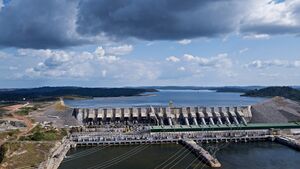
Garindina has historically been an energy efficient country. Until around the 1960s, Garindina was run in coal plants. But after the passing of the 1964 Clean Air Act Garindina started to move away from coal plants. During the Garindinan Civil War, many coal plants were destroyed, but the many Hydropower plants were left alone. As Garindina was still rebuilding, in 2005 Czar Aleksandr began to build wind and solar farms across Garindina, kickstarting the clean energy program. Slowly, Garindina began to move away from Coal and Oil. Today, 67% of all energy production in Garindina is produced by renewable resources.
Energy mix in Garindina.
The Krylov Dam is one of the newest hydropower plants constructed, it is owned by the Canamo Canal Company headed in Prymont. Recently, Garindina has been looking into nuclear energy. The nuclear energy program has been protested by many do to concerns of the ecological effects. Garindina has been an energy exporter in recent years. But with growing energy needs, Garindina might stop exporting energy.
As of now, 46% of Garindina's energy production is from Hydropower plants, with 23% from coal, 14% from wind, 10% from Solar, and 7% from oil.
Industry
Ever since the industrial revolution, Garindina has mainly had a manufacturing based economy. But as of recently, environmental tourism has grown into one of Garindina's largest industries, even passing manufacturing. The manufacturing industry is most prominent in the west of the country. Furthermore, Garindina places emphasis on sustainability and green manufacturing practices. The sector is adopting cleaner and more efficient production processes, reducing waste generation, and implementing eco-friendly initiatives to minimize environmental impact.
Overall, Garindina's manufacturing sector is a dynamic and vital part of the country's economy. It embraces technological advancements, emphasizes quality and innovation, and strives for sustainable growth, positioning Garindina as a competitive player in the global manufacturing landscape. Garindina has also been drilling and refining petrol since its discovery in the Mediargic Sea in 1967.
In recent years, petroleum refinement has become the one of the largest industries in Garindina. Garindina's oil and gas refining industry is a vital sector within the country's economy, playing a significant role in energy production and export.
The entire industry encompasses various activities involved in extracting, refining, and processing crude oil and natural gas resources. The industry also places significant emphasis on environmental sustainability and adheres to stringent regulations to minimize its ecological impact. Garindina's refineries employ advanced technologies to reduce emissions, improve energy efficiency, and implement effective waste management practices.
Furthermore, the oil and gas refining industry in Garindina plays a vital role in driving economic growth and employment opportunities within the region. It attracts investments, creates jobs across various skill levels, and contributes to the overall development of the country.
Mining
Garindina’s mining industry plays a vital role in its industrial sector, ranking among the top five industries. Abundant deposits of Coal, Zinc, Copper, Iron, and Chromium contribute to its economic strength. Additionally, though less prevalent, valuable resources such as Diamond, Platinum, Manganese, and Lead are present. wip
Tourism
WIP (Pictured gallery of National Parks and Parsa, i.e. the Black Hills National Park Black Hills.)
Demographics
Ethnicity
Ethnics diversity chart (2020)
Garindina is a very ethnically diverse nation. Most of the population are considered ethnic Garindinans and Yuzhstovans with large Korelian and Doro communities. With smaller communities of Rusics and Lakkiudiskfolkæ and other smaller ethnic communities. Ethnic tensions are low and very little ethnic violance happens within the country, aside from the occasional descrimination between Garindinans and Korelians.
Religion
The freedom of religion is a guaranteed right in Garindina. Despite this, the national religion being Garindinan Orthodox. Garindinan Orthodox is the most prominent religion practiced in Garindina, with 7.3 million followers within Garindina. In recent years, a growing number of people identify as irreligious, with 1.7 million people identifying as irreligious.
Health
WIP
Culture
Garindina, having many ethnic groups is very culturally diverse. With each ethnic group having their own unique characteristics and traditions. This differentiation of cultures comes from the geography and history of Garindina. Garindinan traditions take roots from the Early Gari People that who migrated to the Paras River Valley during the Late Gari Migration. As a result of the migration, some of these cultures mixed and are similar but still distinct from each other.
Art
WIP
Cuisine
WIP
Education
WIP
Language
WIP
Literature
WIP
Music
WIP
Festivals & Holidays
Garindina has five National Holidays that are celebrated throughout the nation, with a wide verity of activities depending on the day. During Midsummer celebrations, the most prominent celebrations are carnivals and dance. Whilst on Remembrance Day, bonfires and memorials to honor the dead are held.
There are many Regional Holidays that are celebrated by their respected regions as well. These Regional Holidays are celebrated in their own ways that reflect the culture of the area, and sometimes only celebrated in that region. For example, Dyen’ Pervoknyaza, a Yuzhstovan holiday, that is only celebrated in Yuzhstova.
Some notable Festivals include, the Festival of Lent, tbd, and tbd.
National Holidays:
- New year celebrations: Dec 31-Jan 1
- The Czarina's birthday: March 22
- Saint Pavel’s Day: Last Sunday of May
- Midsummer: June 23-25
- Remembrance Day: July 17
- Federation Day: September 2
Notable Regional Holidays:
- Day of the First Prince: April 17, celebrates the crowning of the First Yuzhstovan Knyaz.
- Day of Korelian Speech: July 24, celebrates Korelian Language.
- Day of our Gods: July 4, celebrates the Dorian resistance from Christiansation
- Saint Gleb’s Feast: June 1, Celebrates Saint Gleb for his Virtues of humility and compassion. (Garindinan)
Notable Festivals
- Spring Festivals: April 20-30, Location: Yuzhstova & Doria
- WIP
Sports
WIP




